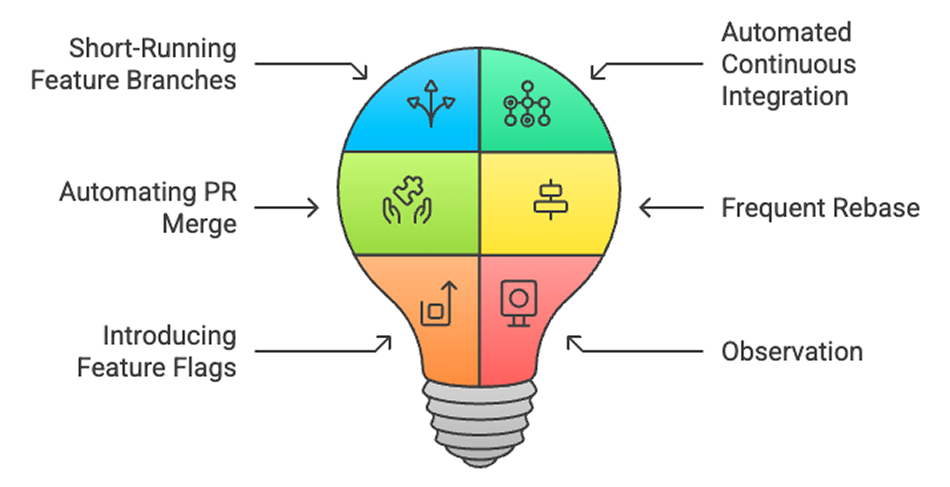Modern software development is all about speed, efficiency, and innovation. Engineers are constantly refining workflows to optimize the software development life cCycle (SDLC). An emerging concept in this pursuit is continuous merge (CM). CM is a natural evolution between continuous integration (CI) and continuous delivery (CD) that simplifies and accelerates code integration without adding unnecessary complexity.
Continues Merge

CI/CD has transformed the way teams build and ship software. But there’s always room for improvement. Continuous merge development takes things a step further—reducing merge conflicts, automating pull request (PR) merges, and ensuring code stays up to date without slowing teams down.
At first, CM might sound like just automating PR merges, but it’s more than that. It builds on CI/CD best practices to create a smoother, conflict-free workflow by focusing on short-lived branches, automated CI, frequent rebasing, feature flags, and continuous monitoring. Following are the building blocks of the continuous merge.
- Short-running feature branches
- Automated continuous integration
- Automating PR merge
- Frequent rebase
- Introducing feature flags
- Observation
Let’s talk about each briefly.
1. Short-Running Feature Branches
- A short-running feature branch is a Git branch quickly merged back into the main branch (main or master) to implement a minor, incremental modification.
- This method prevents significant, complicated merges because developers try to merge their changes in hours or days rather than after weeks of effort on a feature.
2. Automated Continuous Integration
- The developers regularly integrate code into a shared repository using automated continuous integration (CI), automatically testing each integration to identify problems early.
- Continuous integration (CI) ensures new code doesn’t disrupt the existing codebase through automated tests, security scans, and code quality checks before merging.
- This process is also referred to as TestOps in conjunction with DevOps.
3. Automating PR Merge
- Automating pull request merges is a key part of continuous merge. In CI/CD, reviewing PRs often requires a senior engineer’s approval, leading to bottlenecks.
- Continuous merge streamlines the process by enabling the automatic merging of PRs that meet predefined criteria.
- Also, this concept involves continuous integration, which should pass the pipeline with the following checks:
- Linting and static code analysis (e.g., ESLint, Prettier)
- Integrated unit testing
- Security checks
- Code review automation
- Build verification
4. Frequent Rebase
- Although we have talked about short-running branches, rebasing feature branches with the main branch is also beneficial.
- This practice helps minimize merge conflicts by keeping feature branches up to date with the latest changes from the main branch and can simplify conflict resolution.
- A recommended practice is for developers to rebase their feature branches at least once a day to prevent large, complex merges later.
5. Introducing Feature Flags
- A feature flag is a conditional check establishing whether a feature should be active.
- Feature flags help developers avoid long-running branches by enabling them to merge incomplete work without affecting the current code.
6. Observation
Observing the live environment and pipelines is necessary to mitigate the issues in run time. The following steps would be required.
- Ensure the main branch is always deployable.
- Implement staged deployments.
- Use rollback mechanisms for faulty merges.
- Monitor live environments (tools like Prometheus and Grafana will be helpful).
Benefits of CM
Continuous merge is an innovative development technique that encourages frequent code integration to minimize merge conflicts and speed up delivery. These are its main advantages:
- Faster integration and deployment
- Reduced merge conflicts
- Improved code quality
- Enhanced collaboration
- Minimized code staleness
- Supports continuous deployment
- Improved developer productivity
- Easier rollbacks and feature control
What Do You Need To Be Careful of With CM?
While automation is a key component of continuous merge and CI/CD, overreliance on it without human oversight can introduce risks such as:
- Undetected logical errors: Automated tests can only check what they are programmed to validate. They may pass even if the new feature has incorrect business logic.
- False positives/negatives in testing: Automated tests might incorrectly mark buggy code as pass or fail due to flakiness.
- Security vulnerabilities: Automated security scans might miss complex vulnerabilities, leading to potential exploits.
- Lack of context in code reviews: Automated linting and formatting tools can enforce style guidelines but cannot verify design patterns, maintainability, or architecture decisions.
Conclusion
Continuous merge is a method that enhances developer collaboration, accelerates code integration, and minimizes merge conflicts. Its effectiveness depends on balancing automation with manual oversight.
With best practices like short-lived feature branches, feature flags, automated CI/CD pipelines, and thorough reviews, teams can keep continuous merge efficient, scalable, and reliable, leading to quicker and safer software releases.
